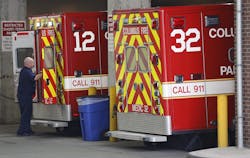If you're injured in a crash or have a medical emergency in the Columbus area but are not in critical condition, your ambulance could be redirected to another hospital if the closest emergency department is not accepting patients.
"Diversion" can occur when a medical facility decides its emergency department is overcrowded or short-staffed. During the past decade, several cities and at least one state have banned such diversions because of concerns about patient deaths and efficiency.
Massachusetts became the first state to ban the practice in 2009 after years of red flags from Boston-area emergency medical services worried about ambulances being tied up and patients whose treatment was delayed.
In Cleveland, the city's four hospital systems made a pact in February 2016 to end ambulance diversion after the city's emergency medical service raised concerns that the policy was inefficient and unsafe.
But health-care providers and emergency medical officials in central Ohio say the diversion process used here does not endanger patients. Many physicians and hospital administrators told The Dispatch that the system here is one of the more efficient ones in the country because of protocols set by the Central Ohio Trauma System, or COTS, the agency that coordinates emergency services for trauma patients.
"There's an ethical debate about things, and frankly, there's reality," Howard Werman, an attending physician at Ohio State University's Wexner Medical Center said. "COTS has done a fabulous job organizing this system and notifying all parties involved to sit down together and put the people of central Ohio at the forefront."
Debating the ethics In 2014, the American Journal of Emergency Medicine published an article on the ethics of ambulance diversion that recommended that authorities "consider the potential positive effects of a regional or statewide ban on diversion."
But that evaluation didn't sit well with Werman and Eric Adkins, two physicians in Wexner's Department of Emergency Medicine. Adkins and Werman, who sits on the editorial board of the journal, wrote a response to the article, citing central Ohio's system and urging health care experts to address emergency room inefficiencies before banning diversion altogether.
The key, they argued, was the partnership with the Columbus Division of Fire and a commitment by all participants never to divert critically unstable patients. During the 1990s, Werman said, Columbus' emergency rooms were like "a canary in a coal mine" as high occupancy rates and nursing shortages caused hospitals to declare they were on diversion and close themselves off to paramedics.
There was no way for health-care facilities to coordinate among themselves or the ambulance squads that radioed the ERs and rushed patients to Columbus hospitals. Werman said he was thrilled when COTS was established in 1995 to open communication between competing hospital systems.
"We go to other areas in the state, and you don't have the same level of cooperation in other localities," Werman said. "It's more tense. Like any other business, hospitals want to develop market share and take care of patients. They are a little bit reluctant to share information, but COTS and our collaborative nature is unique to central Ohio."
What is diversion? Sherri Kovach, executive director of COTS, said she is frequently asked, "What does diversion mean? Why do we do it?" Diversion, she acknowledged, is confusing. In 1999, COTS' board of trustees and Columbus fire officials developed a two-tiered approach to regulating diversions. The only requirement: Hospitals cannot divert patients that EMS personnel deem to be in critical condition.
So any patient being transported for a heart attack, stroke or other life-threatening trauma always will be taken to the closest available hospital. That rule "also extends to specialty patients, people who have a history of cancer (or other long-term illnesses) with a preexisting relationship at one hospital," Kovach said.
Patients also can ask to be taken to a specific hospital for insurance or personal reasons, she added, but the Columbus fire department makes the final call. The first tier in COTS' approach is internal diversion, in which individual emergency departments determine when they are overwhelmed. Those emergency departments then tell Columbus paramedics that they are on diversion and ambulances should be redirected to another facility. The second tier comes into play when three or more hospitals are in diversion at the same time. At that point, the fire department manages a diversion policy called an Emergency Patient Transport Plan.
The transport plan is managed by two fire lieutenants, 15 firefighters and three other personnel who oversee the EMS radio channel in the Fire Alarm Office, Columbus Deputy Fire Chief Shawn Koser said. That office distributes stable patients across remaining emergency departments in a round-robin process.
After every 12 hours, EMS officials check with the facilities that have been diverting patients to determine whether to extend the diversions. Koser estimates that the multisystem plan is triggered roughly six to eight times a year, citing flu season as one of the more common reasons. Health care systems declined to share data on the more common first-tier diversions by individual ERs, citing privacy provisions in federal law. But it appears that diversions occur fairly regularly.
From May 21 through July 24, from 3 to 11:30 p.m. alone, there were at least 19 instances of first-tier diversions and at least two occasions when the diversion plan was initiated, according to a Dispatch analysis of emergency radio traffic.
Despite the stress and the complicated nuances of the policy, Koser said he could not recall any incidents in which patients died or had conditions exacerbated as a result of diversion. Impact Before COTS there was no standardization in diversion situations, said Duane Perry, OhioHealth's free-standing department nursing director. Like Werman, Perry remembers ERs being overcrowded and short-staffed in the 1990s, posting higher numbers of patients than beds.
"We had no strategies to decompress certain locations, and it created a lot of challenges for everyone else in the rest of the city," he said. Under Columbus' current plan, 23 participating emergency departments in Franklin, Delaware and Fairfield counties operated by OhioHealth, Ohio State, Mount Carmel Health System and Nationwide Children's Hospital accept patients during citywide diversion. Fire and EMS agencies outside of Franklin County also coordinate with the Columbus fire department when the plan goes into effect. But the lack of coordination and miscommunication of the 1990s is a thing of the past, according to the four Columbus-based health care systems.
Andrea Light, Mount Carmel East's trauma program manager, said the advantages of COTS go beyond patient transport and have given her the ability to get to know her counterparts at OhioHealth and Wexner.
"From a trauma perspective, it's nice to be able to pick up the phone and ask them, 'Oh, are you having this issue, too?'" she said. In Cleveland, health care professionals say diversion tied up paramedics with longer transports and made communication between the city's emergency services and hospitals inefficient, said Robert Wyllie, the Cleveland Clinic's chief of medical operations.
So 3½ years ago, through the Northern Ohio Trauma System, the four main health care systems in Cleveland agreed to end diversion practices. While Wyllie ultimately believes the decision to use diversion should be a regional choice, he said he thinks central Ohio could move toward a ban.
"With 23 EDs, (diversion) might be the best way for mid-Ohio to act," he said. "But it could also be an initial approach, as people learn to manage diversion, and maybe where you end up is someplace a little closer to northern Ohio."
There are opportunities for COTS members to revise the patient transport plan. Representatives of each health system meet quarterly with Kovach, fire and other city officials to review data and help determine any needed improvements.
"Unlike other systems across the country, we work together instead of working in silos," Kovach said. OhioHealth's Perry agreed that COTS has allowed the Columbus health care community to collaborate on challenges and do what's best for the patient.
"Having an agreed upon, voluntary approach has benefited EMS not to have to drive patients around the city looking for an open ER," he said.
[email protected] @cadoyle_18
___ (c)2019 The Columbus Dispatch (Columbus, Ohio)
Visit The Columbus Dispatch (Columbus, Ohio) at www.dispatch.com
Distributed by Tribune Content Agency, LLC.






